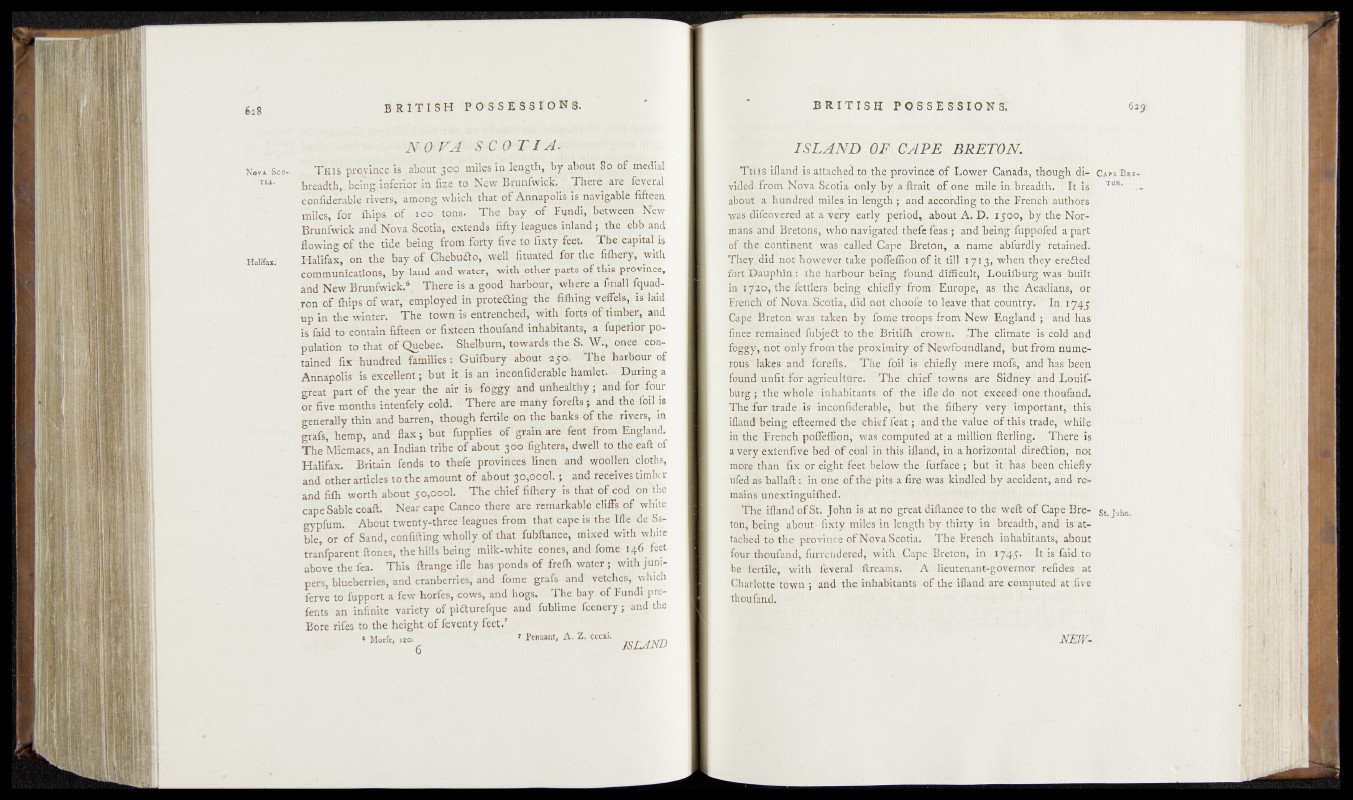
NO FA SC OTI Ar
Nota SCO- * T his province is about 300 miles in length, by about 80 of medial
TU- breadth, being inferior in fize to New Brunfwick. There are ^yeral
confiderafile rivers, among which that oF Anna^l|* is navigat^jfifteen
miles, for ’ Blips of 100’ tons! The 'bay"’ of Fundi, between |£ew
B r u n fw i c k and Nova Scotia, expends fifty teagups inland; t^e ebhvand
flowing of the tide being from forty five to fixty feet. The capital is
Halifax' Halifax, on the bay of Ghebuao, well Situated for the filhefy, | v ith
communications, by land and water,f with other parts <?f t^fe vin ce,
and New Brunfwick.6' There is a good' harbour-where a fmall fquad-
ron of fhips of war, employed im p_rote&ing the
np in-the winter. The town is entrenched, w tV Forts’ of timber, and
faid to'cWain fifteen or fixteen thoufend-inhabitants,"a Superior population
to that of Quebec. Shelburn, towards'the S. W.,' oncd ‘con,
tained fix hundred families: Gurfbury abddt"ij«t 'The harbour <tf
Annapolis is excellent; but it is an ineohfideratble hairileto» I^jlfin'ga
great part of thexear the air-i^ foggy and Unhealthy;- andlo&Mir
or five months intenfely cold. -There are many forefts; and'the.fod is
generally thin and barren, though fertile On-the-banks Of the rivers, in
grafs, hemp, and flax; but fupplies of grain are;feW^rbm 'EtfgMnd.
The Micmacs, an Indian tribe of about 300 fighters, dwell to theeaft of
Halifax. Britain fends to thefe provinces linen and wdoHeh-Tlpths,
and other articles to the amount of about 30^00! 'and receives timber
and fifli worth about 50,000!. The'chief fifhery Is that of cod'oh the
cape Sable coaft. Near cape Canco there are remarkable'bliffs of ^rhite
gypfum. About twenty-three leagues from that cape is She Ifle d# Sable,
or of Sand, confifting wholly of that fubftance,; mixed with white
tranfparent fton.es, the hills being milk-white cones, and fome 146 feet
above the fea. This ftrange ifle has ponds of frefli walter ; with iUni-
pers, blueberries, and cranberries, and fome grafs and vetches, which
ferve to fupport a few horfes, cows, and hogs. The bay of Fundi pre-
fents an infinite variety of pidurefque and fublime fcenery; and the
Bore rife? to the height of feventy feet.7
* Morfe, 1%°-^ 1fnttMt>A-Z‘ CCCXl J S U N D
ISLAND OF QAPE BRETON.
Tnisrifland-is attached to th,q ntqvince'.of Lower Canada, though,,di- Cape E re-
vi^êdKfrorft NoVa'Scotia, oMy.By a-ftrait of,one mile invbreadth^ It is T0M‘
abotp-a hundred milesan length; and a'ccórding'tb the’Ffen,ch'aüthom
was- difcOyereiat a very early period',, about’A. D. '1 fÖo,.’by the Nor-
mads and Bretoh‘s,whonaVig’atèd thèfe feaV;’ and bein'g nipp'ofed a part
ómthepontinent was ckliled Cape Breton-,, a* naifie, aMftrlrfy retained.
They, did not however taledpof&ffion of it when'they èrefted
fon:‘Dauphin : the' harbour being found dianedfc,' Louifburg built
in -1720, the fettiêrs ibeing’ chiefly'from Europe, as the Acadians1, or
FreTTcit of Novrii’Scona;, dio hot CnOofe,*to leave that WuntVy. Ih’ï
Cape Breton was taken by Lome tfobps’from New ®hgl&hd:-; and Ka’s
nnce*]"emained fuBjeift to‘ the Britifli cfown. Thé' climate ’is^Sbld and
foggy,j‘h°t onl'yFrohrthe proximity of’Newfoundland, ‘but’fró'm numerous'
lakes and‘forens. The foil' Jis-£chrefl'y mere T0m^Jahdvlias beêït
fomidnlöfif for agriculltire. ~ The cnief7 towhs" are Si'dn'ey'and Lomf-
bii^^t-fre whole" inhabitants of the* iflè 'dbi*rïöt' eixcee'd-o<h''e tftbufand.
The ’ftft trade iS-%confiderable,' but thfe fllheiy very important,- this
iflatïd’being' efteenied’ the chief feat; and the valued of (his fradé, s-whife
in the French poffeflion, was’cofnputed at a million fterl-ingfl' There is
a vëryi^t^Örvè beft of coal in this ifland, in a feöïikontal dir-edtion, not
mpte than fix or eight féèt-below the furface ; but it hasISb^ftfehlefiy
ufèd aS'ballaft: in one of tKe-pit:s<a; fire'was kindled by accident, and remains
nnextiuguiffied.
The ifland ofStt John is ‘at'ho great diftanfetb'lhe weft-b?jGape-Bre-;’.st'.
toh; being about"fikty mfleS in ldhgïhhyt^hfrti^'fin' breadth, and’> is attached
to the province of Nova Scotia. The French!'inhabitants, about
four, thoufand, furrehdered, with tCape Breton,- in.’ 1745. ' Itis-Laidjo
-bë fertile, with feveral ftreamsv '’ A'‘di'èUtenanC-'goveraloK réfides' at
Charlotte town ; and the inhabitants of the ifland are computed attfive
thbufand. ■
N EW -